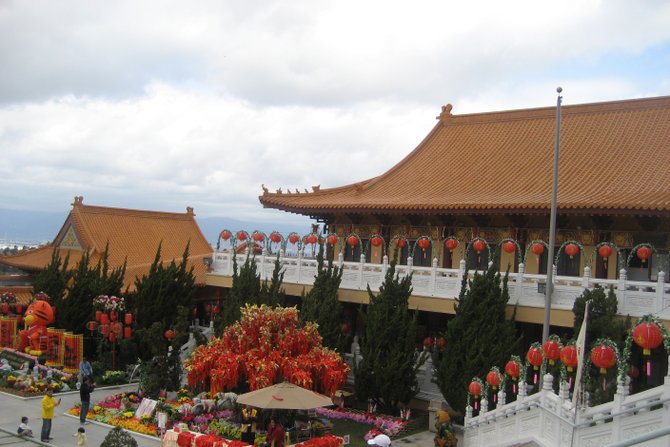 Facebook
Facebook
 X
X
 Instagram
Instagram
 TikTok
TikTok
 Youtube
Youtube

Visiting the Hsi Lai Temple, nestled in the hills of Hacienda Heights, I felt as though I was transported back in time and to another world. Spread out over 15 acres, the temple grounds are surrounded by beautiful structures inspired by Ming and Ching dynasty architecture.
At the center of this Chinese Buddhist temple is a spacious courtyard where many outdoor events are hosted. On this visit, a week after Chinese New Year, the courtyard was filled with colorful decorations from the festivities. There were red lanterns hanging throughout the temple, Chinese dolls and figurines bearing messages of good luck and prosperity, and most importantly, plenty of stuffed tigers (for the Year of the Tiger).
The temple is also a place where many wishes are made. A wishing tree stands on the east side of the courtyard; for a donation, visitors get a red silk ribbon, make a wish and throw it on the tree. On the north side of the courtyard there’s a bell where visitors can drop money into a box, make a wish and ring the bell. There are also plenty of wishing wells and fountains filled with coins around the temple.
Facing the courtyard is a large set of stairs that lead to the main shrine. Atop the stairs just outside the entrance is where visitors burn incense and pray. The main shrine is dedicated to Sakyamuni Buddha (the founder of Buddhism); it is also where most religious services are held. Inside you can place a lighted candle before the Buddha statue as a sign of respect.
You do not have to be Buddhist to come to Hsi Lai Temple – visitors interested in learning about Buddhism and Chinese culture are welcome. Visitors should keep in mind, however, that shorts, miniskirts and tank tops are discouraged.
The temple is open 9 a.m. to 5 p.m. daily. Self-guided audio tours are available for individuals and groups of less than 15 (hsilai.org).


Visiting the Hsi Lai Temple, nestled in the hills of Hacienda Heights, I felt as though I was transported back in time and to another world. Spread out over 15 acres, the temple grounds are surrounded by beautiful structures inspired by Ming and Ching dynasty architecture.
At the center of this Chinese Buddhist temple is a spacious courtyard where many outdoor events are hosted. On this visit, a week after Chinese New Year, the courtyard was filled with colorful decorations from the festivities. There were red lanterns hanging throughout the temple, Chinese dolls and figurines bearing messages of good luck and prosperity, and most importantly, plenty of stuffed tigers (for the Year of the Tiger).
The temple is also a place where many wishes are made. A wishing tree stands on the east side of the courtyard; for a donation, visitors get a red silk ribbon, make a wish and throw it on the tree. On the north side of the courtyard there’s a bell where visitors can drop money into a box, make a wish and ring the bell. There are also plenty of wishing wells and fountains filled with coins around the temple.
Facing the courtyard is a large set of stairs that lead to the main shrine. Atop the stairs just outside the entrance is where visitors burn incense and pray. The main shrine is dedicated to Sakyamuni Buddha (the founder of Buddhism); it is also where most religious services are held. Inside you can place a lighted candle before the Buddha statue as a sign of respect.
You do not have to be Buddhist to come to Hsi Lai Temple – visitors interested in learning about Buddhism and Chinese culture are welcome. Visitors should keep in mind, however, that shorts, miniskirts and tank tops are discouraged.
The temple is open 9 a.m. to 5 p.m. daily. Self-guided audio tours are available for individuals and groups of less than 15 (hsilai.org).
Comments